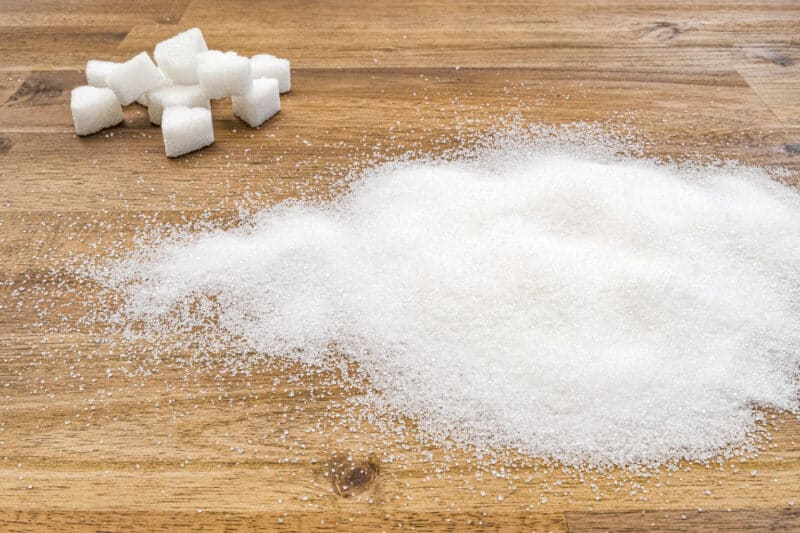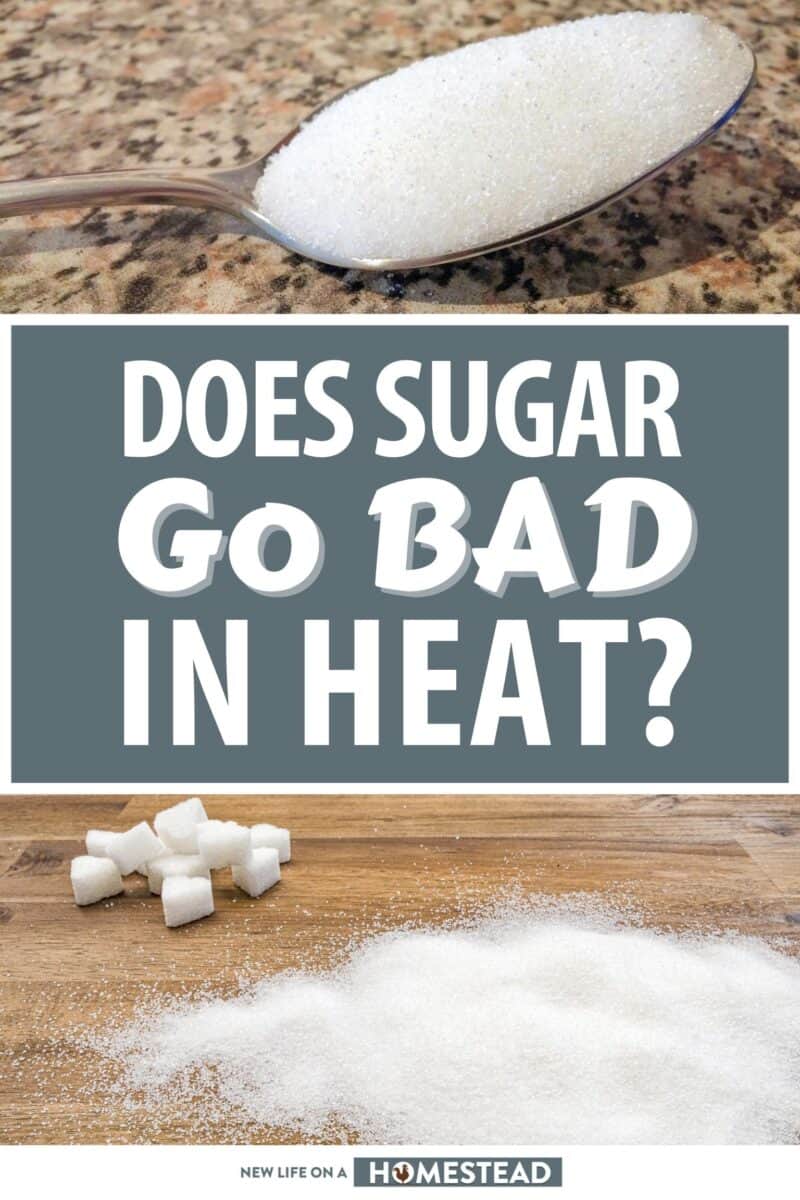There is a lot of debate over whether sugar goes bad in heat. Some people say that it does, and others say that it doesn’t.

So, what’s the truth? You can bake with sugar and there aren’t any problems, but what about leaving it at a lower temperature for longer? Does sugar go bad in heat or not?
No, sugar does not usually spoil or go bad in elevated temperatures. Higher temperatures or temperature fluctuations may result in condensation that causes sugar to clump up or harden, but it is still safe and usable.
However, sugar can readily feed bacteria which can lead to accelerated decomposition or fermentation in other foods.
So, does sugar go bad in heat? Not really, up to point, but it can facilitate other foods going bad.
To further explore and fully answer the question, we need to take a closer look at what happens to sugar when it’s exposed to elevated and high temperatures.
Do Elevated Temperatures in Your Cabinet or Pantry Cause Sugar to Spoil?
We have all found our sugar looking or feeling a little “off” after too long sitting in our pantry or cabinet.
Does this mean it has spoiled? The answer is no, happily: sugar does not spoil from slightly high temps.
However, these higher temperatures can cause it to deteriorate slightly in the form of changed texture and, possibly, taste.
Sugar is hygroscopic, meaning that it absorbs moisture from the air. In warmer, humid conditions, sugar will absorb moisture and become damp.
Over time, this will cause the sugar to form clumps and harden.
In addition, elevated temperatures and moisture can cause the sugar to lose its sweetness and intensify any off-flavors that might have been picked up.
However, this slight deterioration is not spoilage, even if it is slightly unsettling.
Why Does Sugar Clump and Harden?
A large quantity of fine sugar can be frustrating to store long term, as it has a tendency to clump and harden no matter how hard you try to prevent it.
Given enough time, you’ll have to chisel it apart with a spoon or knife! There are a few reasons why this happens.
As mentioned above, sugar is hygroscopic, meaning that it readily absorbs moisture from the air. Also, though sugar readily absorbs water it is itself somewhat soluble in water at room temperature.
When it absorbs moisture from the air, the water molecules begin to dissolve the sugar crystals slightly which then meld together, forming larger conglomerations of crystals.
This process is called hydrolysis, and it can cause the sugar to harden and become difficult to work with.
Finally, elevated temps can also cause sugar to harden while in this state.
When the water molecules evaporate, what’s left behind is a more concentrated solution of sugar, giving these larger chunks a hard, glass-like coating and generally turning your sugar into a block of cement!
How Can I Keep My Sugar from Getting Hard?
While sugar clumping may be annoying, there are a few easy ways to prevent it. First, make sure to store sugar in a tightly sealed container in a cool, dry place.
This will help to keep moisture out and prevent clumping. Second, if you do find your sugar is starting to clump, simply give it a quick stir to break up the chunks before they get worse.
Third, you can also add a handful of uncooked rice to your sugar container. The rice will help absorb any moisture in the air and keep your sugar from clumping.
Is Clumped, Hardened Sugar Still Safe to Use?
Despite the aggravation, clumped, hardened sugar is not spoiled and is still safe to use.
The sugar may have, at worst, lost some of its sweetness, but it is still good for baking and cooking. But making it usable (or rather, measurable!) is easier said than done sometimes.
There are several ways to salvage clumped sugar. One way is to put it in a food processor or blender and pulse until the sugar is broken up.
Another way is to put the sugar in a microwave-safe bowl and heat it in the microwave for 15 to 30 seconds. This will sometimes soften the sugar enough so that it can be easily broken up and used.
If the sugar is still too hard and you can use it in liquid or syrup form, it can be melted in a saucepan over low heat. Once the sugar has melted, it is ready to use.
Clumped, hardened sugar may not be as pretty as fine sugar fresh out of the bag, but it is still just as good.
What Happens to Sugar at Really High Sustained Temperatures?
When sugar is heated to a high enough temperature, it undergoes a chemical transformation known as caramelization.
This process occurs when the sucrose molecules in sugar break down and reform into new compounds.
Caramelization typically occurs between 300 and 350 degrees Fahrenheit, but it can occur at lower temperatures if the sugar is heated for an extended period of time.
The precise outcome of caramelization depends on a number of factors, including the starting temperature, the final temperature, and the amount of time that the sugar is heated.
However, in general, caramelization results in a food that is darker in color and has a richer flavor than the original sugar.
It should be noted that caramelization can be taken too far, in which case the sugar will burn, and burn readily.
When sugar is burned, it turns coal black and takes on a nasty, acrid taste. Now it has officially gone bad!
Sugar burns easily at really high temperatures, and as such you’ll want to carefully watch any high-sugar foods when the oven or stovetop is turned up.
Does Sugar Content Cause Spoilage in other Foods?
Food spoilage is a complex process that can be affected by a number of factors, including temperature, humidity, light exposure, and, of course, sugar content.
While it’s true that sugar can act as a preservative, preventing the growth of bacteria and mold by pulling moisture out of food, it can also encourage the formation of the same.
Sometimes water stays with sugar that is in the food, helping the bacteria and giving them more nourishment to boot!
This is what has likely given rise to the notion that sugar can “go bad” in higher temperatures.
It is actually facilitating the spoilage of high-sugar foods when they are kept warm, but not hot enough to kill germs. That is a sure way to spoil any food!
In addition, sugar can also attract pests such as ants and rodents, which can readily contaminate food and definitely contribute to spoilage.
So while sugar may help to prolong the shelf life of some foods, it can also hasten the spoiling when conditions are right.
Sugar Does Not Really Go Bad in Heat
Sugar generally does not spoil in higher temperatures, though it will usually clump and harden.
While sugar clumping may be annoying, your sugar is still safe and there are a few easy ways to prevent it.
First, make sure to store sugar in a tightly sealed container. This will help to keep moisture out and prevent clumping.
Second, if you do find your sugar is starting to clump, simply give it a quick stir or break it up. You don’t need to worry about your sugar just because it got a little warm.

Tom has lived and worked on farms and homesteads from the Carolinas to Kentucky and beyond. He is passionate about helping people prepare for tough times by embracing lifestyles of self-sufficiency.
